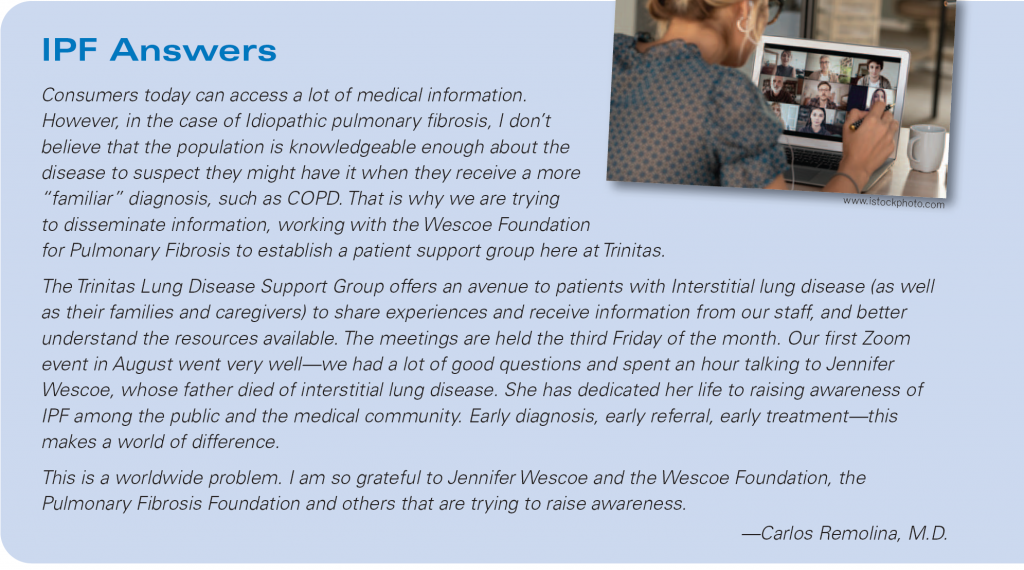
www.istockphoto.com
Doctors and patients can do more to recognize IPF… an elusive disease that literally takes your breath away.
Three years ago, very few people gave serious thought to the health and function of their lungs. As a result of the Covid pandemic, the public gained a profound appreciation for these vital organs. It is one thing to suffer a heart attack or contract a long-term disease, or even to be the victim of an unlucky accident. It is quite another, however, to be unable to breathe. It is truly terrifying.

www.istockphoto.com
As a pulmonologist, I see patients every day struggling with a variety of breathing issues. Some are curable and others manageable but, unfortunately, some do not have a good long-term prognosis. One in particular is of what happens to the lungs in patients that suffer from Idiopathic pulmonary fibrosis. Idiopathic pulmonary fibrosis, or IPF for short. Fibrosis means that the lungs are getting thick and hard. To understand, think of an individual breathing in and out with a normal lung. That lung is like a sponge—you can squeeze it and it comes right back. No problem. Now imagine that sponge is thrown in the backyard for a couple of weeks—and think about how hard and stiff it would feel when you squeeze it. That gives you an idea of what happens to the lungs in patients that suffer from Idiopathic pulmonary fibrosis.
The number of patients officially diagnosed with IPF suggests it is an exceedingly uncommon disease. There are as many as 132,000 cases in the US, with 50,000 new cases diagnosed annually. The fact is that, because the symptoms are not specific, IPF can be mistaken for other more common diseases, such as COPD, which means the actual number of cases is likely much higher. IPF commonly goes undiagnosed, often for many months to years. If the possibility of IPF is overlooked on the initial visit, it takes three to five doctors before the correct diagnosis is secured.
Which is a problem, because IPF patients are living on borrowed time. From diagnosis to death, they may only have five years.
What complicates the situation is that the symptoms of IPF are not specific. They include a cough that is dry and non-productive, as well as increasing shortness of breath. However, if a doctor examines patients with the possibility of IPF in mind, there are several signs that can point towards the appropriate diagnosis. They include clubbing of the fingers, Velcro crackles and acrocyanosis—a bluish discoloration of the extremities—among others. More on these symptoms later.
It is a lack of awareness of signs like these that causes a delay in the diagnosis, which is why I have devoted a great deal of time toward raising awareness among healthcare providers and the public of IPF.
Slow and Insidious
Interstitial Lung Disease (ILD) encompasses a diverse group of conditions that cause lung fibrosis. There are approximately 150 different diseases that are part of ILD, one of which is Idiopathic pulmonary fibrosis. These are fairly rare diseases—so much so that most doctors do not always think of them. When patients are referred to doctors with shortness of breath and cough, those patients will be diagnosed most likely with COPD, bronchial asthma, or chronic bronchitis. That translates into thousands of people who go on living their lives while they are actually dying from IPF, believing they have something else. The fact is that many doctors do not think of IPF when the disease might just be staring them right in the face.
IPF is slow and insidious. It usually begins with a cough or increasing shortness of breath to the point where patients realize that they cannot do the things they’re used to doing, such as walking a few blocks or going up a staircase. That’s what triggers the initial physician visit. If there is a history of smoking, COPD is the immediate suspect and the IPF diagnosis may be missed in that critical initial visit.
IPF occurs more frequently in men than women, typically in the later years, after age 60. IPF patients tend to be, or have been, smokers; they have been ignoring what they believe is a “smoker’s cough.” When healthcare providers listen to them with a stethoscope, they don’t really hear anything. Often they figure it is bronchitis, prescribe them an antibiotic, and that’s it.
Eventually, a patient’s persistent, repetitive cough does not improve and the shortness of breath gets noticeably worse…that is when doctors will start looking for other, less-obvious causes.
The unfortunate thing, as mentioned earlier, is that patients might see several doctors with the same symptoms before they are correctly diagnosed. It takes time before the patient is sent to a specialist, and not all specialists are focused on making the diagnosis. Pulmonologists are trained how to diagnose and treat IPF; they are your best bet for getting to an appropriate diagnosis.
Why is IPF so elusive? One reason is that the signs and symptoms are non-specific, and because of all the different diseases that can present similarly. Consequently, in its early stages, some symptoms of IPF may look like other conditions. It is important for doctors to have an open mind and consider the diagnosis of ILD and pursue a differential diagnosis that will lead them to the diagnosis of IPF.
IPF Clues
There are clues that doctors can look for that will lead them down the path toward an IPF diagnosis. The most important is the cough. It is a cough that is dry, non- productive and repetitive. That cough is the most common presentation. The others, as mentioned earlier, are increasing shortness of breath and the inability of Also, when I listen to a COPD patient’s lungs, I hear distant sounds, diffuse rhonchi or expiratory wheezes. By contrast, in IPF, I hear those Velcro crackles—that distinct sound similar to when you separate one piece of Velcro from another. patients to exert themselves as they had before. COPD, by contrast, usually has a cough that produces phlegm.
Other clues I look for include a patient who may be breathing faster than normal and, sometimes, when I look at a patient’s hands with IPF I may observe a rounding condition of the nails called “clubbing.” Also, I may observe Raynaud’s phenomenon, where their fingers feel cold and are discolored. In patients with scleroderma, one may see “sausage fingers.” All of these can be associated with ILD, although they are not exclusive to the disease.
Surprisingly, chest x-rays are not very helpful in diagnosing Idiopathic pulmonary fibrosis. The ideal test is a non-contrast high-resolution CT scan. It can provide doctors with some clues that are otherwise difficult to detect, including honeycombing, subpleural reticulation and traction bronchiectasis, which is a “pulling” on the bronchi. If I see those three things in a CT scan, chances are a patient has IPF. Needless to say, it is important that a radiologist knowledgeable in ILD is looking for these signs, too. We are also encouraging pathologists to recognize signs of IPF when an open lung biopsy is done, because that is not always the case.
Unfortunately, there is no cure for IPF. However, in some cases, we can consider lung transplantation. For a variety of reasons, the number of transplants is very small, including the fact that many IPF patients are elderly and they might not have the strength to survive a procedure like this, or because the disease has progressed too far. Also, there is a shortage of donors. In my practice, we’ve been working with different medical centers on lung transplants. Recently, I have had patients receive transplants at Temple University in Philadelphia; Mt. Sinai and NYU Langone in New York, and Newark Beth Israel Medical Center, where I have been working closely with Dr. Joshua Lee. For many diseases, a major issue in treatment, is that patients wait too long to go to the doctor. For the most part, this is not the case with IPF. I cannot stress enough that Idiopathic pulmonary fibrosis is a disease where, the more closely a doctor looks, the more a doctor will find. The lack of awareness across a broad spectrum of disciplines—including primary caregivers, radiologists, pathologists and others—makes this diagnosis elusive. It is incumbent upon us to recognize IPF when we first encounter it because, for these individuals, the clock is ticking.
Finally, if you are a patient who has been told you have COPD and you are not satisfied with that diagnosis, seek another opinion. If your condition persists and you’re not getting better, get someone else to look at it. Sometimes a pair of different eyes can make all the difference.











